In today’s classroom environment, teachers constantly look for ways to create a calm and productive atmosphere for their students. One effective solution that is gaining popularity is the concept of the “calm down corner.” Providing students with tools and strategies to manage their emotions is more important than ever. This designated space within the classroom allows students to retreat to a calm and soothing area when they feel overwhelmed or need a moment to focus.
All children need the opportunity to practice managing their emotions. The idea behind the “calm down corner” is to give students a haven to engage in relaxation techniques, manage their emotions, and regain focus without disrupting the rest of the classroom. Designated calming spaces can be a helpful tool for children who feel overwhelmed or overstimulated.
Read this article guide for more tips for creating a safe, welcoming, and calming corner. Develop emotional resilience, improve focus, and ultimately enhance your students’ overall learning experience by implementing a calm corner in your classroom.
What is a Calming Corner?
A calming corner, or quiet or calm down corner, is a designated space within a classroom or home where children can relax, manage their emotions, and regain composure. It is designed to provide a tranquil environment with calming elements such as soft pillows, soothing colors, sensory toys, calming music, or books. The purpose of a calming corner is to help children self-regulate their emotions, reduce stress, and improve their ability to focus and learn. This space can be particularly beneficial for young children in managing feelings of anxiety, frustration, or overstimulation.
What Are the Benefits of a Calm Down Corner?
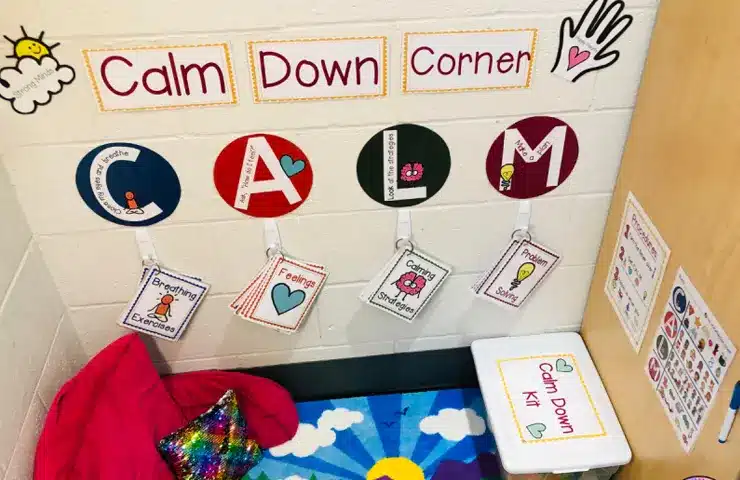
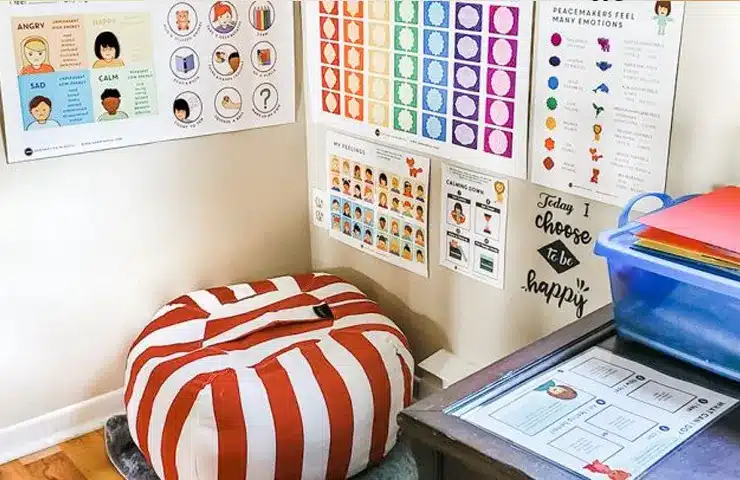
A calm-down corner offers several benefits for children. It helps students develop self-regulation skills, reduces classroom distractions, and provides a safe space for emotional expression. particularly in educational settings such as kindergartens and elementary schools. Here are some key advantages:
- Emotional Regulation: It provides children with a dedicated space to manage and process their emotions, helping them to develop self-regulation skills.
- Stress Reduction: The calm and soothing environment helps reduce stress and anxiety, allowing children to return to their activities feeling more relaxed and focused.
- Improved Focus: After spending time in the calm down corner, children are often better able to concentrate and participate in classroom activities.
- Conflict Resolution: It offers a space where children can cool down and think about resolving conflicts peacefully, fostering better social interactions.
- Independence: Using the calm down corner teaches children to recognize their emotional needs independently and take appropriate steps to address them.
- Positive Behavior: By providing an alternative to punitive measures, calm down corner encourages positive behavior management strategies.
- Sensory Regulation: For children with sensory processing issues, a calm down corner can offer a quiet retreat to manage sensory overload.
- Empathy and Understanding: It helps other children understand that feeling strong emotions is okay and that taking time to calm down is a healthy response.
A calm corner can significantly improve classroom management. Teachers can reduce the frequency and intensity of emotional outbursts by providing a dedicated space for students to manage their emotions. This leads to a quieter, more focused classroom where learning can occur without interruption.
Research supports the effectiveness of calm down corners in improving student behavior and academic performance. Studies have shown that students who regularly use these spaces demonstrate increased emotional regulation, reduced anxiety, and improved focus and concentration.
Set Up Effective Calm Down Corner Tips
Creating a calm down corner in the classroom involves thoughtful planning and strategic use of space and resources. This dedicated area should have tools and materials to help children self-regulate their emotions and behaviors.
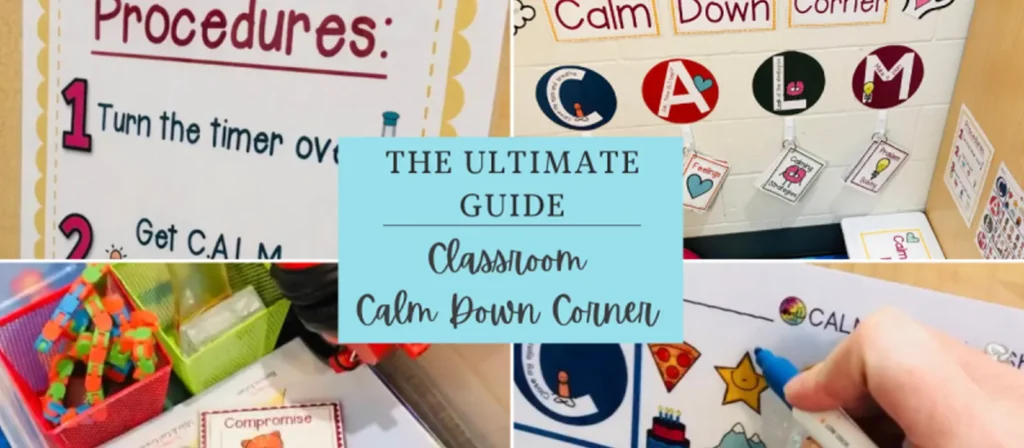
1. Use Calming Colors
Choosing classroom colors is important. Using calming colors can significantly impact the effectiveness of your calm down corner. Colors like blue, green, and soft pastels are known to have a soothing effect on the mind. These colors help reduce anxiety and create a peaceful atmosphere.
Choose colors that promote tranquility. Blue is associated with calmness, green with nature, and pastels with comfort. Avoid bright, stimulating colors like red or orange, which can increase stress and agitation. Incorporate these colors in the classroom furniture, wall decor, and fabrics.
2. Incorporate Emotional Awareness
Emotional awareness is a critical component of a successful calm down corner. Use tools like emotion charts to help students identify and understand their feelings. Emotion journals encourage students to write about their emotions, fostering self-reflection. Provide books that discuss emotions and coping strategies. Guided meditation and breathing exercises can also be included to help students manage their emotions effectively. By integrating these resources, students can better understand and regulate their feelings.
3. Set Rules and Expectations
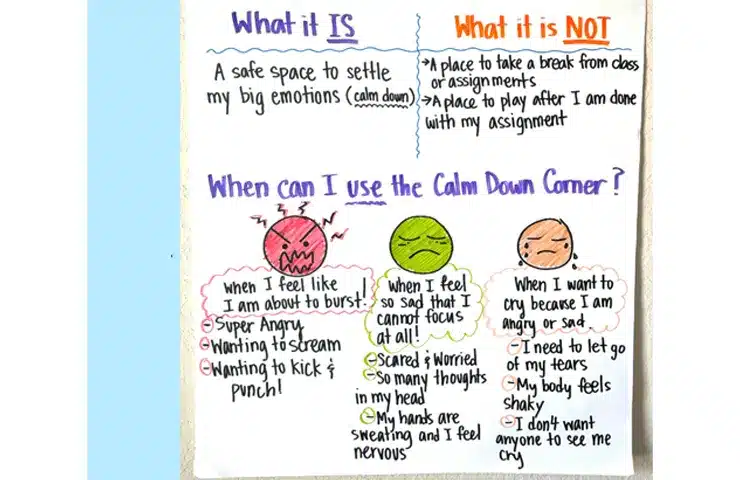

Clear rules and expectations ensure the calm down corner is used effectively. Define when and how students can use the space, emphasizing that it is a supportive tool, not a punishment.
Set a time limit for use, typically 5-10 minutes. Establish behavior guidelines to maintain the quiet, reflective nature of the space. Regularly review and reinforce these rules to ensure understanding and compliance.
4. Provide Sensory Programs
Sensory programs include fingertip toys, sensory bottles, and textured materials to engage students’ senses and help them regulate their emotions.
5. Choose the Right Location
Select a quiet, low-traffic classroom area that provides privacy and minimal distractions. Ensure the space is large enough to be comfortable but not intrusive. Incorporate elements like soft lighting and comfortable seating to enhance the calming atmosphere. Mark the area and provide instructions on its use to ensure it is easily identifiable and accessible.
6. Close Contact with Nature
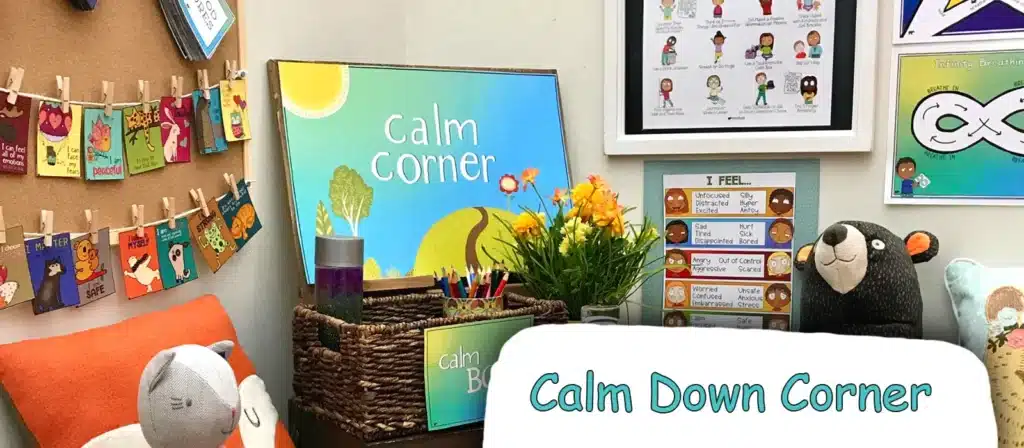
Integrating natural elements into your calm down corner can significantly enhance its calming effects. Nature has a well-documented impact on reducing stress and promoting relaxation.
Bring potted plants, flowers, or even a minor indoor water feature to create a tranquil environment. Natural light is also essential, so position the corner near windows if possible. Images or posters of nature scenes can be used if live plants aren’t feasible. These elements help create a peaceful atmosphere where students feel connected to nature, reducing stress and promoting well-being.
7. Sound is Important
The right auditory elements can help students relax and focus. Consider using soft, soothing music or nature sounds like flowing water or birdsong in your calm down corner. White noise machines can also be effective in drowning out distracting classroom sounds. Providing noise-canceling headphones allows students to control their auditory environment, making it easier for them to calm down and regain focus.
8. Share Breathing Techniques in the Calm Down Corner
Teaching and practicing breathing techniques can be incredibly effective in helping students manage their emotions.
Provide visual aids or simple instructions for deep, box, or balloon breathing techniques. Having posters or laminated cards with these instructions in the calm down corner makes it easy for students to follow along. Practicing these techniques regularly helps students develop the skills they need to calm themselves during stressful moments.
9. Encourage Positive Self-Talk
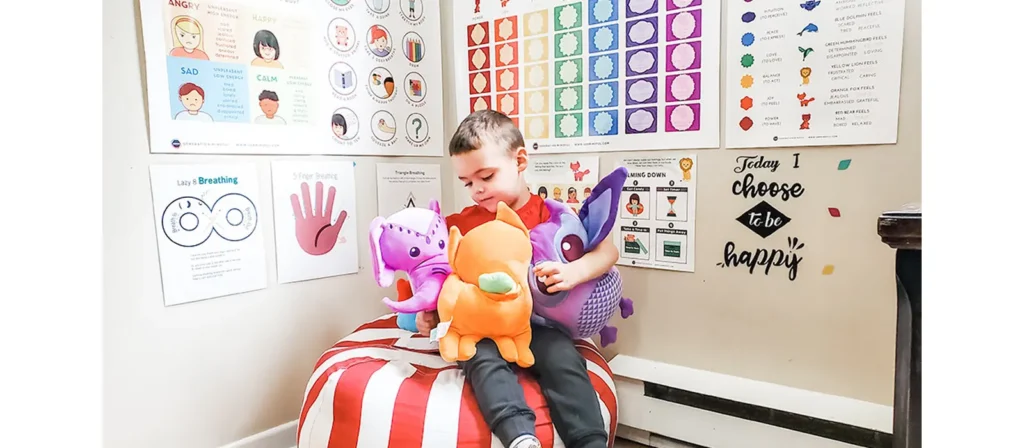
Positive self-talk is a powerful tool for managing emotions and building resilience. Encourage students to use affirmations and positive statements to counter negative thoughts.
Include resources like affirmation cards, posters with positive messages, and journals where students can write down positive thoughts and achievements. Teach students to replace negative self-talk with positive affirmations, such as “I can handle this” or “I am in control of my emotions.” This practice can boost their confidence and emotional resilience.
10. Practice Self-Reflection
Self-reflection is a crucial component of emotional regulation. It helps students understand their emotions and reactions, fostering greater self-awareness.
Provide tools like journals, reflection sheets, or prompts that guide students through self-reflection. Encourage students to think about what triggered their emotions, how they reacted, and what they can do differently next time. This practice helps them learn from their experiences and promotes a growth mindset.
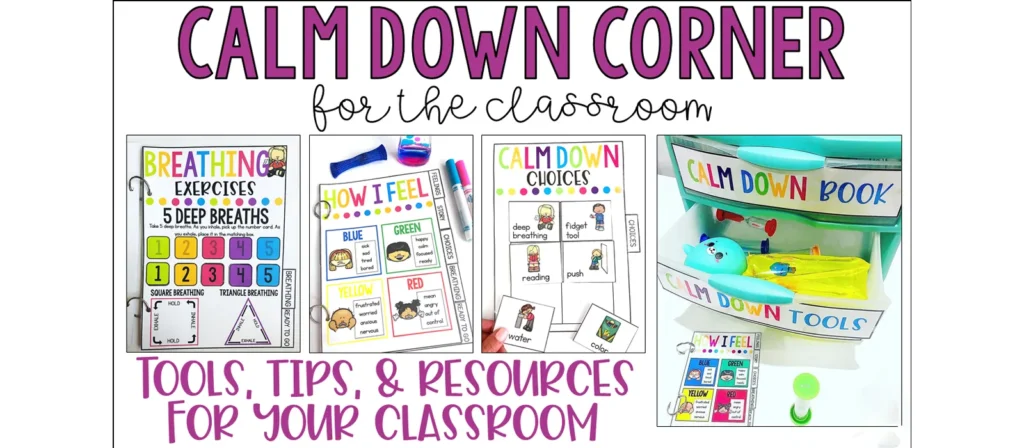
11. Provide Visual Support
Visual supports are crucial for helping students understand and manage their emotions. Tools like emotion charts and visual schedules can guide students in identifying their feelings and the steps they can take to calm down.
12. Provide Communication Forms
Effective communication is key to emotional regulation. Providing various forms of communication tools helps children express their needs and feelings more effectively.
Include items like emotion cards, communication boards, or even a small whiteboard where students can write or draw their feelings. These tools empower children to communicate when they might not have the words to express their emotions verbally, helping them feel understood and supported.
13. Pay Attention to Lighting
Opt for soft, natural lighting when possible. If your classroom doesn’t have sufficient natural light, consider using soft white bulbs or adjustable lamps to create a calm ambiance. Avoid harsh fluorescent lights, which can be overstimulating. Calming string lights or small lamps can also add a comforting touch to the space.
14. Provide Cooling Tents

Cooling tents or small enclosed spaces can offer students a sense of security and privacy, making calming down easier.
A cooling or small pop-up tent in the classroom can be used as a personal retreat in the calm corner. Fill it with soft cushions, blankets, and sensory toys to create a cozy and inviting environment. The enclosed space can help children feel safe and removed from the classroom’s hustle and bustle, allowing them to relax and reset.
15. Mindfulness Activities
Incorporating mindfulness activities into your calm down corner can help students develop emotional regulation skills and promote relaxation.
Provide resources like mindfulness cards, guided meditation scripts, and breathing exercises. These activities teach students to focus on the present moment, reduce stress, and improve their emotional awareness. Simple mindfulness practices, such as deep breathing, visualization, and body scans, can be highly effective in helping students calm their minds and bodies.
What Rules Can Be Established for a Calm Down Corner?
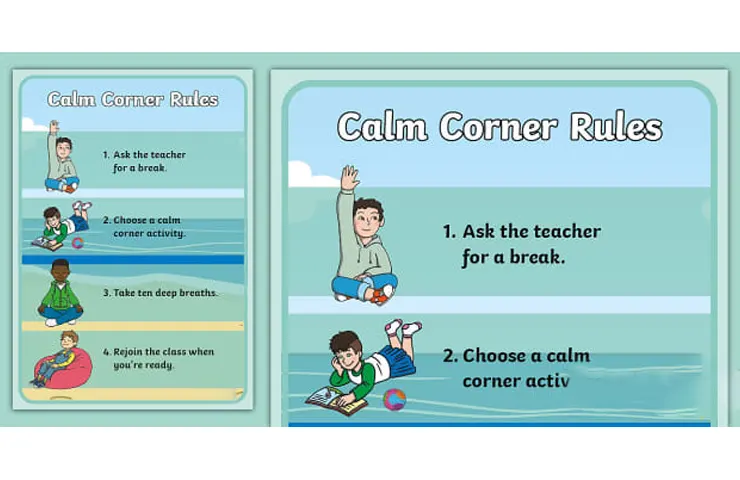
Establishing clear rules for a calm down corner helps ensure the space is used effectively and respectfully. These rules should be simple, consistent, and communicated clearly to all students.
- Use When Needed: Only use the calm down corner when you feel upset, angry, or overwhelmed and need a break to calm down.
- Time Limit: Spend a reasonable amount of time in the calm down corner, typically 5-10 minutes, to ensure others can use it too.
- Quiet Time: Maintain a serene environment in the calm down corner to help yourself and others relax.
- Respect the Space: Take care of the items in the calm down corner, such as pillows, toys, books, and other calming tools.
- No Disruptions: Do not disturb others using the calm down corner.
- Return Items: Put items back in their designated places when you leave the calm down corner.
- Ask for Help: If you need assistance or additional support while in the calm down corner, ask a teacher or caregiver for help.
- No Food or Drink: Avoid bringing food or drinks into the calm down corner to keep it clean and pleasant for everyone.
Regularly review and reinforce these rules with students. Use class meetings, role-playing, and visual reminders to ensure everyone understands and follows the guidelines. Involving students in creating and revising the rules can also increase their ownership and adherence to the expectations.
By following these rules, children can maximize the benefits of the calm down corner and maintain a peaceful and supportive environment for themselves and their peers.
Indoor and Outdoor Calm Down Corners
While indoor calm down corners are standard, outdoor calm down corners can also be incredibly beneficial. These spaces provide students with a natural environment to relax and reset, which can be particularly soothing.
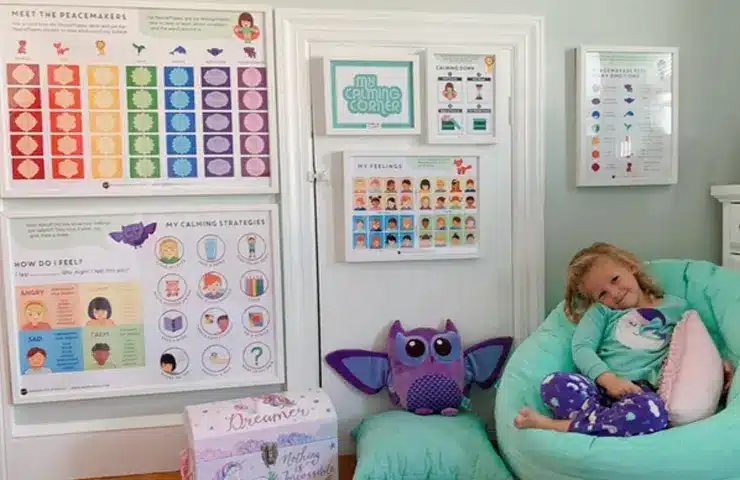
Indoor Calm Down Corners
Indoor calm down corners are typically located in a quiet classroom corner. They are equipped with various tools and materials to help students calm down and manage their emotions. Common items include:
- Soft seating like bean bags or cushions
- Sensory tools like stress balls and fidget toys
- Visual aids such as emotion charts and calming posters
- Books or coloring materials for quiet activities
- Noise-canceling headphones to reduce sensory input
Indoor calm down corners should be easily accessible yet away from high-traffic areas to ensure privacy and minimal distractions. Use calming colors and decor to create a peaceful atmosphere.
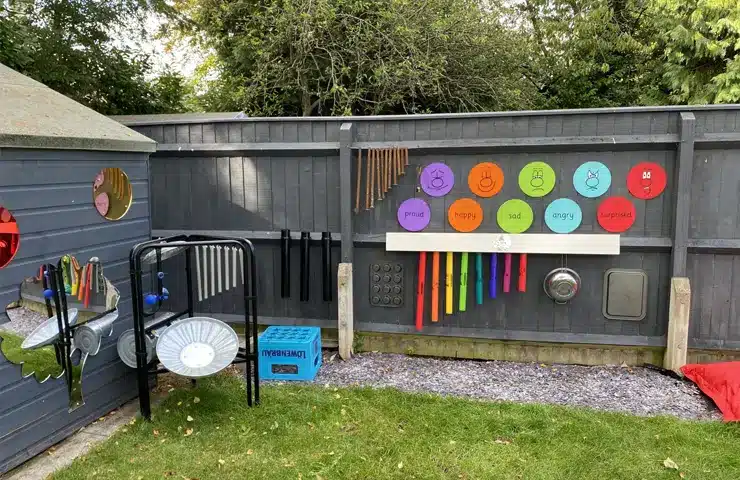
Outdoor Calm Down Corners
Outdoor calm down corners take advantage of nature’s calming effects. These can be set up in a quiet area of the schoolyard or playground. Outdoor calm down corners might include:
- A bench or seating area surrounded by plants
- A small garden or nature area where students can observe and interact with nature
- Sensory items like sand trays or water tables
- Visual and auditory elements like wind chimes or water fountains
Outdoor spaces allow students to connect with nature, which has been shown to reduce stress and improve mood. Fresh air and natural light further enhance the calming effects of these spaces.
Both indoor and outdoor calm down corners should be tailored to the specific needs and preferences of the students. Regularly assess and update these areas to ensure they remain effective and engaging.
How Can You Assess the Effectiveness of Your Calm Down Corner?
Assessing the effectiveness of your calm down corner is crucial to ensure it meets the needs of your students. Regular assessment helps identify areas for improvement and ensures the space continues to provide the intended benefits.

1. Collect Feedback
Gathering student feedback is one of the best ways to assess the effectiveness of the calm down corner. Ask students how they feel about the space, what they find helpful, and any suggestions they have for improvement. This can be done through surveys, informal conversations, or reflection journals.
2. Observe Usage Patterns
Pay attention to how and when students use the calm down corner. Are they using it frequently? Do they seem calmer and more focused after using the space? Are there certain times of the day or specific triggers that lead to more frequent use? Observing these patterns can provide valuable insights into the corner’s effectiveness.
3. Monitor Behavior Changes
Track changes in student behavior before and after implementing the calm down corner. Look for reductions in emotional outbursts, improved self-regulation, and increased focus and engagement in classroom activities. Positive behavior changes indicate that the calm down corner is serving its purpose.
4. Reflect on Academic Performance
Improved emotional regulation often leads to better academic performance. Monitor students’ academic progress using the calm down corner to see any correlations. Look for improvements in grades, participation, and overall academic achievement.
5. Adjust and Improve
Based on the feedback and observations, make necessary adjustments to the calm down corner. This might involve adding new materials, changing the layout, or updating the rules and guidelines. Continually refining the space ensures it remains effective and meets the evolving needs of your students.
Conclusion
Creating a calm down corner in your classroom can transform the learning environment by providing a safe space for students to manage their emotions. By embracing the concept of a calm down corner, we empower our students to navigate their emotions effectively, leading to a more harmonious and productive classroom.
If you are still confused or have any other questions about kindergarten education, please contact us! Let’s start building these important spaces today!












